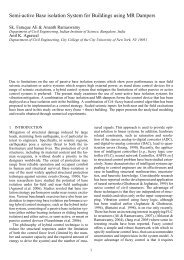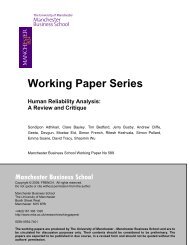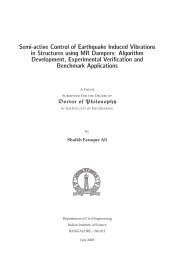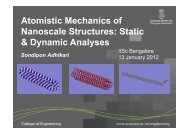TOWARDS IDENTIFICATION OF A GENERAL MODEL OF DAMPING
TOWARDS IDENTIFICATION OF A GENERAL MODEL OF DAMPING
TOWARDS IDENTIFICATION OF A GENERAL MODEL OF DAMPING
You also want an ePaper? Increase the reach of your titles
YUMPU automatically turns print PDFs into web optimized ePapers that Google loves.
In view of equations (2.2)−(3.3) and considering that only mmodes are measured, separating real and imaginary parts ofẑ j one can writeû j = ˆx j +ˆv j =m∑à kjˆx k ; à kj =k=1k≠jm∑˜B kjˆx k ; ˜Bkj =k=1k≠jˆµˆω j(ˆµ 2 + ˆω 2 j ) B kjˆµ 2(ˆµ 2 + ˆω 2 j ) B kj.(3.5)Here the unknown constants B kj = ˆω j C kj′ . Note that in additionto B kj , the relaxation constant ˆµ and the undampedˆωj 2−ˆω2 kmodes ˆx k are also unknown. Combining these equations,û j = ˆx j + ˆωj ˆvj. (3.6)ˆµBecause the undamped modes are orthonormal with respectto the mass matrix, from equation (3.6) it may be observedthat the imaginary part of the complex mode ˆv j isM-orthogonal to its corresponding undamped mode so thatˆv j T Mˆx j = 0. Premultiplying equation (3.6) by ˆv j T M and summing∀j = 1, · · · , m one can writem∑m∑{}ˆv j T Mû j = ˆv j T Mˆx j + ˆωjˆµ ˆvT j Mˆv jj=1j=1Use of the orthogonality property of ˆv j and ˆx j leads toˆµ =(3.7)∑ mj=1 ˆωjˆvT j Mˆv j∑ mj=1 ˆvT j Mûj . (3.8)This ˆµ can be substituted in (3.6) to obtain the undampedmodes. Now, ∀j = 1, · · · , m the second equation of (3.5)can be arranged in a matrix form and the ˜B kj can be calculatedusing the Moore-Penrose pseudoinverse. From theseconstants C kj ′ and consequently, using the undamped modes,the coefficient matrix C can be obtained. This coefficient matrixtogether with the relaxation parameter ˆµ completely definesthe damping mechanism in the structure. In summary,this procedure can be described by the following steps:1. Measure a set of transfer functions H ij(ˆω). Fix the numberof modes to be retained in the study, say m. Determinethe complex natural frequencies ˆλ j and complexmode shapes ẑ j from the transfer function, for allj = 1, · · · m. Denote Ẑ = [ẑ 1, ẑ 2, · · · ẑ m] ∈ C N×m thecomplex mode shape matrix.2. Evaluate the ‘undamped natural frequencies’ as ˆω j =R(ˆλ j).]]3. Set Û = R[Ẑ = [û 1, û 2, · · · û m] and ˆV = I[Ẑ =[v 1, ˆv 2, · · · ˆv m].4. Obtain the relaxation parameter ˆµ =∑ mj=1 ˆωjˆvT j Mˆv j∑ mj=1 ˆvT j Mûj .5. For all j = 1, {· · · , m calculate } the ‘undamped modeshapes’ ˆx j = û j − ˆωjˆµ ˆvj . Set ˆX = [ˆx 1, ˆx 2, · · · ˆx m] ∈R N×m .6. Evaluate the matrix ˜B =[ ] −1ˆX T ˆX ˆX T ˆV.7. From the ˜B matrix get C ′ kj = (ˆω2 j − ˆω 2 k)ˆω j(ˆµ 2 + ˆω 2 j )ˆµ 2 ˜Bkjfor k, j = 1, 2 · · · m; k ≠ j and C jj ′ = 2I(ˆλ j) (ˆµ2 + ˆω j 2 ).ˆµ[ 2 ( ) ] −1 T [ ( ]−18. Use C = ˆX T X ˆX T C ′ ˆX ˆX) T ˆX T to getthe coefficient matrix in physical coordinates.Using this procedure we need only the complex natural frequencies,mode shapes and mass matrix to identify the bestexponential damping model associated with the measurements.The method is very simple and does not require muchcomputational time. Another advantage is that a complete setof modal data is not necessary to estimate the relaxation parameteras well as the full coefficient matrix. It may be observedthat even if the measured transfer functions are reciprocal,from the above mentioned procedure there is no reasonwhy the fitted coefficient matrix C will always be symmetric. Ifwe indeed detect a non-symmetric C then it may be guessedthat the physical law behind the damping mechanism in thestructure can not be described by an exponential model. Thisfact will be discussed later by considering a example in Section4.The procedure described above can also be used to identifythe familiar viscous damping matrix as a special case by forcingˆµ → ∞. In this case it is easy to see that û j → ˆx j i.e.,the real part of the complex modes approach the undampedmodes and all the steps described above remain valid. Interestingly,as step 4 is avoided, knowledge of the mass matrixis also not essential. Thus only complex natural frequenciesand mode shapes are sufficient to identify the ‘best’ full (nonproportional)viscous damping matrix.4 NUMERICAL EXAMPLESThere is a major difference in emphasis between this studyand other related studies on damping identification reportedin the literature. Most of the methods assume from the outsetthat the system is viscously damped (see the review paperby Pilkey and Inman [15]) and then formulate the theory toidentify a viscous damping matrix. Here, we wish to investigatehow much one can learn by fitting viscous and exponentialdamping models when the actual system is non-viscouslydamped, as one must expect to be the case for most practicalsystems. We study by simulation a system which has aknown non-viscous damping model. Two different physicallyrealistic non-viscous damping models are considered in thisstudy. They are applied to a system consisting of a linear arrayof spring-mass oscillators and dampers shown in Figure 1.For the numerical values considered the resulting undampednatural frequencies range from near zero to approximately 200Hz. Certain of the masses of the system shown in Figure 1(a)have dissipative elements connecting them to the ground. Inthis case the damping force depends only on the absolute motionof the individual masses. Such damping will be described
as ‘locally reacting’. For the system shown in Figure 1(b), bycontrast, dissipative elements are connected between certainadjacent pairs of masses. In this case the damping force dependson the relative motion of the two adjacent masses, andwill be called ‘non-locally reacting’.(a)kuk umumuk uk ug(t)m um ukuk ug(t)g(t)(b)Figure 1: Linear array of N spring-mass oscillators, N = 30,m u = 1 Kg, k u = 4 × ×10 3 N/m.The dissipative elements shown in Figure 1 are taken to be linearnon-viscous dampers so that the equations of motion aredescribed by (1.1). Complex natural frequencies and modescan be calculated for the model system using equations (2.2)and (2.3), then treated like experimental data obtained froma modal testing procedure. Note that in a true experimentalenvironment the measured complex natural frequenciesand mode shapes will be contaminated by noise. Since thesimulated data are noise-free the results obtained using themare ‘ideal’, the best one can hope using this approach. Oncepromising algorithms have been identified in this way, the influenceof noise in degrading the performance will have to beaddressed.Two specific damping models will be considered, defined bytwo different forms of g(t):Model 1 (exponential):mum u. . .. . .k uk umum ug (1) (t) = µ 1e −µ 1tk uk u(4.1)√Model 2 (Gaussian): g (2) µ2(t) = 2π e−µ 2t 2 (4.2)where µ 1 and µ 2 are constants. It is convenient to normalizethe functions to make comparisons between models meaningful.Both functions have been scaled so as to have unit areawhen integrated to infinity. This makes them directly comparablewith the viscous model, in which the corresponding dampingfunction would be a unit delta function, g(t) = δ(t), andthe coefficient matrix C would be the usual dissipation matrix.It is also convenient to define a characteristic time constant,θ j for each damping function, via the first moment of g (j) (t):θ j =∫ ∞0t g (j) (t) dt (4.3)For the two damping models considered here, evaluating theabove integral gives θ 1 = 1µ 1and θ 2 = √ 1πµ2. For viscousdamping θ j = 0. The characteristic time constant of a dampingfunction gives a convenient measure of ‘width’: if it is closeto zero the damping behaviour will be near-viscous, and viceversa. To establish an equivalence between the two dampingmodels we can choose that they have the same time constant.For both the systems shown in Figure 1, the dampers are associatedonly between the s-th and (s + l)-th masses. Forthe numerical calculations considered here, we have takenN = 30, s = 8 and (s+l) = 17. Various values of the time constantθ have been tested for both the damping models. Theseare conveniently expressed as a fraction of the period of thehighest undamped natural frequency:θ = γT min (4.4)When γ is small compared with unity the damping behaviourcan be expected to be essentially viscous, but when γ is oforder unity non-viscous effects should become significant.Results For Small θWhen γ = 0.02 both damping models should show nearviscousbehaviour. First consider the system shown in Figure1(a) with locally reacting damping. Figure 2 shows the fittedviscous damping matrix for damping model 2, calculated usingthe complete set of 30 modes. The fitted matrix identifies thedamping in the system very well. The high portion of the plotcorresponds to the spatial location of the dampers. The offdiagonalterms of the identified damping matrix are very smallcompared to the diagonal terms, indicating correctly that thedamping is locally reacting.Fitted viscous damping matrix C kj25201510503025201510500Figure 2: Fitted viscous damping matrix for local case,γ = 0.02, damping model 2It is useful to understand the effect of modal truncation on thedamping identification procedure. In practice, one might expectto be able to use only the first few modes of the systemto identify the damping matrix. Figure 3 shows the fitted viscousdamping matrix using the first 10 modes only. The qualityof the fitted damping matrix deteriorated as the number ofmodes used to fit the damping matrix is reduced, but still theidentified damping matrix shows a reasonable approximationto the true behaviour. The spatial resolution of the identified51015202530
damping is limited by that of the set of modes used, and someoff-diagonal activity is seen in the fitted matrix. Since for thissystem the mode shapes are approximately sinusoidal, wecan recognize the effects of modal truncation as analogousto Gibbs phenomenon in a truncated Fourier series.Fitted viscous damping matrix C kj1086420302520151050051015202530When the fitting procedure is repeated using any other dampingmodel with a similarly short characteristic time constant,the result are very similar. The detailed difference in their functionalbehaviour does not influence the results significantly.In summary, we can say that when the time constant for adamping model is small the proposed identification methodworks quite well regardless of the functional form of the dampingmechanism. The spatial location of damping is revealedclearly and associated relaxation parameter shows high valuewhether it is locally or non-locally reacting. Modal truncationblurs the results, but does not invalidate the identification process.Results For Larger θWhen γ is larger the two non-viscous damping models departfrom the viscous damping model, each in its own way. Forthe value γ = 0.5, Figure 5(a) shows the result of fitting aviscous damping matrix for damping model 1 (equation (4.1))with locally-reacting damping and the full set of modes. It mayFigure 3: Fitted viscous damping matrix using first 10modes, γ = 0.02, damping model 2Fitted coefficient matrix C kj6050403020100Fitted viscous damping matrix C kj8765432103025201510500510152025303025201510500Figure 4: Fitted coefficient matrix of exponential model fornon-local case, γ = 0.02, damping model 2Now consider the system shown in Figure 1(b) with non-locallyreacting damping. So far we have shown the results for fittingof viscous damping model. Figure 4 shows the fitted coefficientmatrix of exponential model for damping model 2, usingthe full set of modes. The high portion of the plot correspondsto the spatial location of the dampers. The negativeoff-diagonal terms in the identified damping matrix indicatethat the damping is non-locally reacting. We also observedthat the fitted characteristic time constant ˆθ is small, sothat ˆγ = 0.0201. This implies that the identified (exponential)model is near to viscous. Thus the proposed method identifiesthe correct damping model quite well and gives a goodestimate of the correct characteristic time constant.51015202530Figure 5(a): Fitted viscous damping matrix for local case,γ = 0.5, damping model 1be noted that although we have started with a locally reactingdamping model, which means the matrix is non-zero onlyalong the diagonal, the non-zero values in the off-diagonalterms show that the fitted viscous damping is, in a sense,not locally reacting. Nevertheless, the spatial distribution ofthe damping is well identified, and perhaps one might be ableto guess that the underlying mechanism was locally-reactingfrom the fact that the significantly non-zero elements all havepositive values, with a clear peak centred on the diagonal ofthe matrix. Figure 5(b) shows the result of fitting the exponentialmodel for this problem. Since the model is ‘identified’correctly in this case, the correct value of the relaxation parameteris obtained, and the coefficient matrix corresponds tothe exact coefficient matrix for the problem.Figure 6(a) shows the corresponding fitted viscous dampingmatrix for damping model 2 (equation (4.2)). Features of thefitting are similar to those of Figure 5(a). The result of fittingthe exponential model for this problem is shown in Figure 6(b).
Fitted coefficient matrix C kj9876543210of the simulated model. However, since the ‘identified’ modelis not correct, because the original model is Gaussian whilethe fitted model is exponential, the coefficient matrix does notcorrespond to the exact coefficient matrix for the problem. Infact the result of fitting of the exponential model is not very differentfrom fitting a viscous model (Figure 6(a)). From this resultwe conclude that when the characteristic time constant ofa damping model is long an incorrect damping model may notaccurately indicate the actual damping behaviour of a structure.3025201510500Figure 5(b): Fitted coefficient matrix of exponential modelfor local case, γ = 0.5, damping model 1Fitted viscous damping matrix C kj65432103025201510500Figure 6(a): Fitted viscous damping matrix for local case,γ = 0.5, damping model 2Fitted coefficient matrix C kj98765432103025201510500Figure 6(b): Fitted coefficient matrix of exponential modelfor local case, γ = 0.5, damping model 2For the characteristic time constant of the fitted exponentialmodel, ˆγ = 0.6415 which is not very different from the exact γ555101010151515202020252525303030A useful check on the accuracy of these procedures is tocompare the ‘measured’ and reconstructed transfer functions.For the examples considered here it was observed (resultsnot shown) that the reconstructed transfer function agreed remarkablywell with the original one. This is to be expected:the fitting procedure outlined in the previous section is exact,within the approximations of the small-damping perturbationtheory, provided the full set of modes is used. The full setof poles and their residues are correctly reproduced — this isthe essential contrast between this approach and one whichfits only proportional damping, for which the poles can be correctbut the residues cannot (because they will be real, notcomplex). This result has a far-reaching implication: an incorrectdamping model (eg. , the fitted viscous damping) with adifferent spatial distribution from the true damping model canreproduce accurately the full set of transfer functions. Thismeans that by measuring transfer functions it is not possibleto identify uniquely the governing mechanism.However, it should be noted that in cases like Figures 5(a),6(a) and 6(b) the fitted coefficient matrix is not symmetric.This is, in some sense, a non-physical result. In view of thisnon-symmetry, the reciprocity of the transfer functions waschecked and it was observed that they are indeed reciprocalwithin an acceptable accuracy. Thus the non-symmetry ofthe fitted coefficient matrix in the spatial coordinate does notnecessarily affect the reciprocity of the transfer functions. Instead,we should regard non-symmetry of a fitted coefficientmatrix as evidence that the true damping model is not the onewhich is fitted . To obtain a correct physical description of thedamping, a symmetry preserving non-viscous model shouldbe fitted instead.From equation (2.3) we can deduce that, within the approximationof small damping, each frequency function G ′ kj(ω) canbe observed at only two frequencies, ω j and ω k . When thefitted coefficient matrix turns out to be non-symmetric, this indicatesthat it was not possible to fit the assumed functionthrough both ‘measured’ frequency points, and two differentcoefficients were needed. To correct this problem, it is necessaryto fit a different damping model with sufficient free parametersto pass through both measured points while retainingsymmetric coefficients. The function cannot be uniquely determinedby this requirement, of course. Research is currentlyin progress to explore models of this kind, and their associatedfitting algorithms.
5 CONCLUSIONSIn this paper a method has been proposed to identify a nonproportionalnon-viscous damping model in vibrating systems.It is assumed that damping is light so that the first order perturbationmethod is applicable. The method is simple, direct,and compatible with conventional modal testing procedures.The complex modes and natural frequencies are used, but themethod does not require the full set of modal data. Identificationof the familiar viscous damping model is a special case ofthe general method proposed here. In that case, knowledge ofthe mass and stiffness matrices are also not necessary. Thevalidity of the proposed method has been explored by applyingit to simulated data from a simple test problem, in which a lineararray of spring-mass oscillators is damped by non-viscouselements over part of its length.Numerical experiments have been carried out with a widerange of parameter values and different damping models. Themain features of the results have been illustrated by two particulardamping models and representative parameter values.It has been shown that the method generally predicts the spatiallocation of the damping with good accuracy, and also givesa good indication of whether the damping is locally-reactingor not. Whatever the nature of the fitted coefficient matrix,the transfer functions obtained using the fitted damping agreewell with the exact transfer functions of the simulated system.Reciprocity of the transfer functions remains preserved withinan acceptable accuracy although in some cases the fitted coefficientmatrix is not symmetric.Symmetry breaking of the fitted coefficient matrix depends onthe value of the characteristic time constant θ of the dampingmodel, defined by equation (4.3). When θ is short comparedwith the natural periods of the vibration, the damping is effectivelyviscous and the fitting procedure gives a physicallysensiblesymmetric matrix. When θ is larger, though, thememory of the damping function influences the detailed behaviour.In this case, if the fitted damping model is wrong,the procedure yields a non-physical result by fitting a nonsymmetriccoefficient matrix. That is, the procedure gives anindication that a wrong model is selected for fitting. Investigationsare under way to fit symmetry-preserving models undersuch conditions.ACKNOWLEDGEMENTSFunding provided by Trinity College, Cambridge and CambridgeCommonwealth Trust is greatly acknowledged.REFERENCES[1] Rayleigh, L., Theory of Sound (two volumes), DoverPublications, New York, 1945th edn., 1877.[2] Caughey, T. K. and O’Kelly, M. E. J., Classical normalmodes in damped linear dynamic systems, Transactionof ASME, Journal of Applied Mechanics, Vol. 32,pp. 583–588, September 1965.[3] Sestieri, A. and Ibrahim, R., Analysis of errors and approximationsin the use of modal coordinates, Journal ofSound and Vibration, Vol. 177, No. 2, pp. 145–157, 1994.[4] Lazan, B. J., Damping of Materials and Members inStructural Mechanics, Pergamon Press, Oxford, 1968.[5] Bert, C. W., Material damping: an introductory review ofmathematical models, measure and experimental techniques,Journal of Sound and Vibration, Vol. 29, No. 2,pp. 129–153, 1973.[6] Ungar, E. E., The status of engineering knowledge concerningthe damping of built-up structures, Journal ofSound and Vibration, Vol. 26, pp. 141–154, 1973.[7] Nashif, A. D., Jones, D. I. G. and Henderson, J. P.,Vibration Damping, John Wiley, New York, 1985.[8] Baburaj, V. and Matsukai, Y., A study on the materialdamping of thin angle-ply laminated plates, Journal ofSound and Vibration, Vol. 172, No. 3, pp. 415–419, 1994.[9] Earls, S. W. E., Theoretical estimation of frictional energydissipation in a simple lap joint, Journal of MechanicalEngineering Science, Vol. 8, No. 2, pp. 207–214,1966.[10] Beards, C. F. and Williams, J. L., The damping of structuralvibration by rotational slip in structural joint, Journalof Sound and Vibration, Vol. 53, No. 3, pp. 333–340,1977.[11] Bandstra, J. P., Comparison of equivalent viscousdamping in discrete and continuous vibrating system,Transaction of ASME, Journal of Vibration, Acoustics,Stress and Reliability in Design, Vol. 105, pp. 382–392,July 1983.[12] Biot, M. A., Linear thermodynamics and the mechanicsof solids, Proceedings of the Third U. S. NationalCongress on Applied Mechanics, pp. 1–18, ASME, NewYork, 1958.[13] Woodhouse, J., Linear damping models for structuralvibration, Journal of Sound and Vibration, Vol. 215, No. 3,pp. 547–569, 1998.[14] Cremer, L. and Heckl, M., Structure-Brone Sound,Springer-Verlag Berlin, Germany, 2nd edn., 1973, translatedby E. E. Ungar.[15] Pilkey, D. P. and Inman, D. J., Survey of damping matrixidentification, Proceedings of the 16th InternationalModal Analysis Conference (IMAC), Vol. 1, pp. 104–110,1998.






